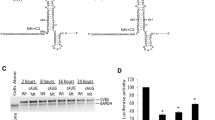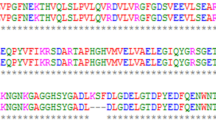Abstract
The domain V within the internal ribosome entry segment (IRES) of poliovirus (PV) is expected to be important in its own neurovirulence because it contains an attenuating mutation in each of the Sabin vaccine strains. In this study, we try to find out if the results observed in the case of Sabin vaccine strains of PV can be extrapolated to another virus belonging to the same genus of enteroviruses but with a different tropism. To test this hypothesis, we used the coxsackievirus B3 (CVB3), known to be the most common causal agent of viral myocarditis. The introduction of the three PV Sabin-like mutations in the equivalent positions (nucleotides 484, 485, and 473) to the domain V of the CVB3 IRES results in significant reduced viral titer of the Sabin3-like mutant (Sab3-like) but not on those of Sab1- and Sab2-like mutants. This low titer was correlated with poor translation efficiency in vitro when all mutants were translated in rabbit reticulocyte lysates. However, elucidation by biochemical probing of the secondary structure of the entire domain V of the IRES of Sabin-like mutants reveals no distinct profiles in comparison with the wild-type counterpart. Prediction of secondary structure by MFOLD program indicates a structural perturbation of the stem containing the Sab3-like mutation, suggesting that specific protein-viral RNA interactions are disrupted, preventing efficient viral translation.




Similar content being viewed by others
References
Agol VI (1992) The 5′-untranslated region of picornaviral genomes. Adv Virus Res 40:103–179
Almond JW (1987) The attenuation of poliovirus neurovirulence. Annu Rev Microbiol 41:153–180
Baboonian C, Davies MJ, Booth JC, McKenna WJ (1997) Coxsackie B viruses and human heart disease. In: Tracy S, Chapman NM, Mahy BWJ (eds) The coxsackie B viruses. Springer-Verlag, Berlin, pp 31–52
Belsham GJ, Sonenberg N (1996) RNA-protein interactions in regulation of picornavirus RNA translation. Microbiol Rev 60:499–511
Borman AM, Deliat FG, Kean KM (1994) Sequences within the poliovirus internal ribosome entry segment control viral RNA synthesis. EMBO J 13:3149–3159
Bowles NE, Towbin JA (1998) Molecular aspects of myocarditis. Curr Opin Cardiol 13:179–184
Cherry JD (1998) Enteroviruses: coxsackieviruses, enteroviruses, and polioviruses. In: Feigin RD, Cherry JD (eds) Textbook of pediatric infectious diseases. Saunders WB Co, Philadelphia, pp 1787–1839
Cheung P, Zhang M, Yuan J, Chau D, Yanagaw B, McManus B, Yang D (2002) Specific interactions of HeLa cell proteins with Coxsackievirus B3 RNA: La autoantigen binds differently to multiple sites within the 5′ untranslated region. Virus Res 90:23–36
Dunn JJ, Bradrick SS, Chapman MN, Tracy S, Romero RJ (2003) The stem loop II within the 5′ nontranslated region of clinical coxsackievirus B3 genomes determines cardiovirulence phenotype in a murine model. J Infec Dis 187:1552–1561
Dunn JJ, Chapman MN, Tracy S, Romero RJ (2000) Genomic determinants of cardiovirulence in coxsackievirus B3 clinical isolates: localization to the 5′ nontranslated region. J Virol 74(10):4787–4794
Ehrenfeld E (1996) Initiation of translation by picornavirus RNAs. In: Hershey JWB, Matews MB, Sonenberg N (eds) Translational control. Cold Spring Harbor Laboratory Press, New York, pp 549–573
Gharbi J, El Hiar R, Ben M’hadheb M, Jaïdane H, Bouslama L, N’saïbia S, Aouni M (2006) Nucleotide sequences of IRES domains IV and V of natural ECHO virus type 11 isolates with different replication capacity phenotypes. Virus Genes 32:269–276
Gutierrez AL, Denova-Ocampo M, Racaniello VR, del Angel RM (1997) Attenuating mutations in the poliovirus 5′ untranslated region alter its interaction with polypyrimidine tract-binding protein. J Virol 71:3826–3833
Hellen CU, Wimmer E (1995) Enterovirus genetics. In: Rotbart HA (ed) Human enterovirus infection. American Society for Microbiology, Washington, DC, pp 25–72
Hellen CU, Witherell GW, Schmid M, Shin SH, Pestova TV, Gil A, Wimmer E (1993) A cytoplamsic 57-kDa protein that is required for translation of picornavirus RNA by internal ribosomal entry is identical to the nuclear pyrimidine tract-binding protein. Proc Natl Acad Sci USA 90:7642–7646
Hunt SL, Jackson RJ (1999) Polypyrimidine-tract-binding protein (PTB) is necessary, but not sufficient, for efficient internal initiation of translation of human rhinovirus-2 RNA. RNA 5:344–359
Jackson RJ, Hunt T (1983) Preparation and use of nuclease-treated rabbit reticulocyte lysates for the translation of eukaryotic messenger RNA. Methods Enzymol 96:50–74
Kawamura N, Kohara M, Abe S, Komatsu T, Tago K, Arita M, Nomoto A (1989) Determinants in the 5′ noncoding region of poliovirus Sabin1 RNA that influence the attenuation phenotype. J Virol 63:1302–1309
Klump WM, Bergmann I, Muller BC, Ameis D, Kandolf R (1990) Complete nucleotide sequence of infectious coxsackievirus B3 cDNA: two initial 5′ uridine are regained during plus-strand RNA synthesis. J Virol 64:1573–1583
Knowlton KU, Jeon ES, Berkley N, Wessely R, Huber S (1996) A mutation of the puff region of VP2 attenuates the myocarditic phenotype of an infectious cDNA of the woodruff variant of coxsackievirus B3. J Virol 70:7811–7818
Kolupeava VG, Hellen CU, Shatsky IN (1996) Structural analysis of the interaction of the pyrimidine tract-binding protein with the internal ribosomal entry site of encephalomyocarditis virus and foot-and-mouth disease virus RNAs. RNA 2:1199–1212
Krausslich HG, Wimmer E (1988) Viral proteinases. Ann Rev Biochem 57:701–754
La Monica N, Racaniello VR (1989) Differences in replication of attenuated and neurovirulent polioviruses in human neuroblastoma cell line SH-SY5Y. J Virol 63:2357–2560
Le SY, Siddiqui A, Maizel JV (1996) A commun structural core in the internal ribosome entry sites of picornavirus, hepatitis C virus and pestivirus. Virus Genes 12:135–147
Lee YF, Nomoto A, Detjen BM, Wimmer E (1977) The genome linked protein of picornaviruses: a protein covalently linked to poliovirus genome RNA. Proc Natl Acad Sci USA 74:59–63
Lee C, Maull E, Chapman N, Tracy S, Gauntt C (1997) Genomic regions of coxsackievirus B3 associated with cardiovirulence. J Med Virol 52:341–347
Macadam AJ, Ferguson G, Burlison J, Stone D, Skuce R, Almond JW, Minor PD (1992) Correlation of RNA secondary structure and attenuation of Sabin vaccine strains of poliovirus in tissue culture. Virology 189:415–422
Malnou EC, Werner A, Borman MA, Westhof E, Kean MK (2004) Effects of vaccine strain mutations in domain V of the internal ribosome entry segment compared in the wild type poliovirus type 1 context. J Biol Chem 279:10261–10269
Marczinke B, Fischer R, Vidakovic M, Bloys AJ, Brierly I (1998) Secondary structure and mutational analysis of the ribosomal frame shift signal of Rous sarcoma virus. J Mol Biol 284:205–225
Meyer K, Peterson A, Niepmann M, Beck E (1995) Interaction of eukaryotic initiation factor eIF-4B with picornavirus internal translation initiation. J Virol 69:2819–2824
Minor PD (1992) The molecular biology of poliovirus. J Gen Virol 73:3065–3077
Modlin JF, Rotbart HA (1997) Group B coxsackievirus disease in children. Curr Top Microbiol Immunol 223:53–80
Moss EG, O’Neill RE, Racaniello VR (1989) Mapping of attenuating sequences of an avirulent poliovirus type 2 strain. J Virol 63:1884–1890
Ochs K, Zeller A, Saleh L, Bassili G, Song Y, Sonntag A, Niepmann M (2003) Impaired binding of standard initiation factors mediates poliovirus translation attenuation. J Virol 77:115–122
Rinehart LO, Gomez RM, Root RP (1997) Molecular determinants for virulence in coxsackievirus B1 infection. J Virol 71:3986–3991
Rohll JB, Percy N, Ley R, Evans DJ, Almond JW, Barclay WS (1994) The 5′-untranslated regions of picornavirus RNAs contain independent functional domains essential for RNA replication and translation. J Virol 68:4384–4391
Rueckert RR (1996) Picornaviridae: the viruses and their replication. In: Fields BN, Knipe DM, Howley PM (eds) Fundamental virology. Lippincott-Raven Publishers, Philadelphia, pp 477–522
Sambrook J, Fritsch EF, Maniatis T (1989) Molecular cloning: a laboratory manual. Cold Spring Harbor Laboratory Press, New York
Skinner MA, Racaniello VR, Dunn G, Cooper J, Minor PD, Almond JW (1989) New model for the secondary structure of the 5′ non-coding RNA of poliovirus is supported by biochemical and genetic data that also show that RNA secondary structure is important in neurovirulence. J Mol Biol 207:379–392
Stadnick E, Dan M, Sadeghi A, Chantler JK (2004) Attenuating mutations in coxsackievirus B3 map to a conformational epitope that comprises the puff region of VP2 and the knob of VP3. J Virol 78(24):13987–14002
Stanway G (1990) Structure, function and evolution of picornaviruses. J Gen Virol 71:2483–2501
Svitkin YV, Cammack N, Minor PD, Almond JW (1990) Translation deficiency of the Sabin type 3 poliovirus genome: association with an attenuating mutation C472-U. Virology 175:103–109
Svitkin YV, Maslova SV, Agol VI (1985) The genomes of attenuated and virulent poliovirus strains differ in their in vitro translation efficiencies. Virology 147:243–252
Svitkin YV, Pestova AE, Maslova SV, Agol VI (1988) Point mutations modify the response of poliovirus RNA to a translation initiation factor: a comparison of neurovirulent and attenuated strains. Virology 166:394–404
Teterina NL, Kean MK, Gorbalenya AE, Agol VI, Girard M (1992) Analysis of the functional significance of amino acid residues in the putative NTP-binding pattern of the poliovirus 2C protein. J Gen Virol 73:1977–1986
Tu Z, Chapman MN, Hufnagel G, Tracy S, Romero JR, Barry WH, Zhao L, Currey K, Shapiro B (1995) The cardiovirulent phenotype of coxsackievirus B3 is determined at a single site in the genomic 5’ nontranslated region. J Virol 69:4607–4618
Westrop GD, Wareham KA, Evans DMA, Dunn G, Minor PD, Magrath DI, Taffs F, Marsden S, Skinner MA, Schild GC, Almond JW (1989) Genetic basis of attenuation of the Sabin type 3 oral poliovirus vaccine. J Virol 63:1338–1344
Wimmer E, Hellen CU, Cao X (1993) Genetics of poliovirus. Annu Rev Genet 27:353–436
Yang D, Wilson JE, Anderson DR, Bohunek L, Cordeiro C, Kandolf R, McManus B (1997) In vitro mutational and inhibitory analysis of the sis-acting translational elements within the 5′ untranslated region of Coxsackievirus B3: potential targets for antiviral action of antisense oligomers. Virology 228:63–73
Zuker M, Mathews DH, Turner DH (1999) Algorithms and thermodynamics for RNA secondary structure prediction: a practical guide. In: Barciszewski J, Clarck BFC (eds) RNA Biochemstry and Biotechnology. Kluwer Academic Publishers, Dordrecht, The Netherlands, pp 11–43
Acknowledgments
We thank Dr. Willem J. G. Melchers from The Radboud University Medical Centre of Nijmegen (The Netherlands), for giving pRibCB3/T7 plasmid. We are also grateful to the support staff, Saskia Ballet and Alex Ansleme-Vatin. This work was financed by research projects from the Franco-Tunisian cooperation (DGRST-CNRS code 04/R0902 and CMCU code 04/G0810). M. B.M-G was supported by grants from CNRS, CMCU, Ministère Tunisien de l’Enseignement Supérieur (bourse d’alternance) and Ministère Tunisien de la Recherche Scientifique et du Développement des Compétences (Lab MDT-01).
Author information
Authors and Affiliations
Corresponding author
Additional information
Communicated by S. Hohmann
Rights and permissions
About this article
Cite this article
Ben M’hadheb-Gharbi, M., Gharbi, J., Paulous, S. et al. Effects of the Sabin-like mutations in domain V of the internal ribosome entry segment on translational efficiency of the Coxsackievirus B3. Mol Genet Genomics 276, 402–412 (2006). https://doi.org/10.1007/s00438-006-0155-3
Received:
Accepted:
Published:
Issue Date:
DOI: https://doi.org/10.1007/s00438-006-0155-3




